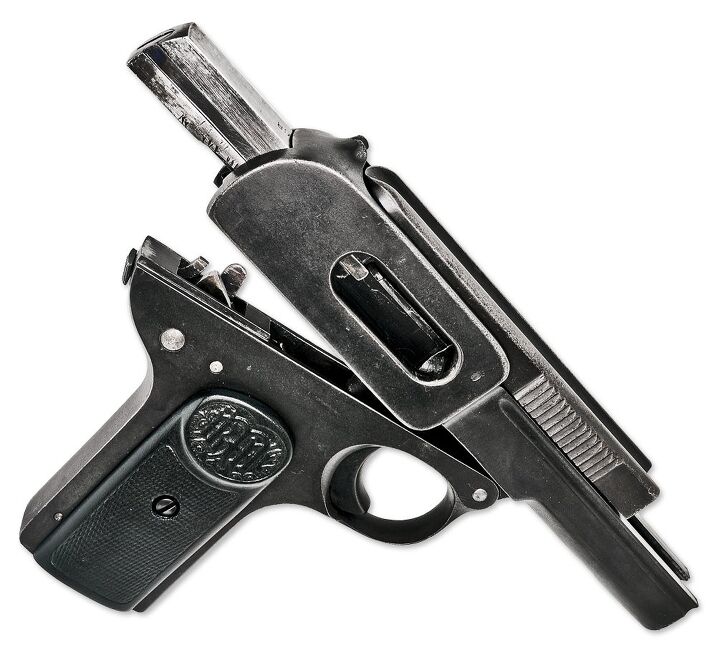Browning’s FN-licensed Model 1900 pocket .32ACP was a world first and defined the general shape and layout of a slide operated handgun. It’s popularity led to “Browning” serving as the word for a semi-automatic pistol in many regions, like we say “Kleenex” today.
We take the ubiquitous pistol slide for granted these days but at the time all of these “obvious” features were quickly patented and represented a major stumbling block for competing designs. Patent-dodging explains quite a few odd looking firearms from the early years such as the Winchester 1911 S.L. “Widowmaker” shotgun, early “zig-zag” revolvers to avoid Colt’s patents, and here the Dreyse avoiding the patents of the Model 1900.
 Now, much of the frame and breech block of this pocket-sized blowback pistol is extremely similar to the 1900. A casual observer can see the general layout, grip angle, overall dimensions, safety operation and placement, and cartridge are meant to capitalize on the Model 1900’s recognition in the market. At a glance the Dreyse is a likely candidate for a lawsuit!
Now, much of the frame and breech block of this pocket-sized blowback pistol is extremely similar to the 1900. A casual observer can see the general layout, grip angle, overall dimensions, safety operation and placement, and cartridge are meant to capitalize on the Model 1900’s recognition in the market. At a glance the Dreyse is a likely candidate for a lawsuit!
The Dreyse does have a breech face integrated into a moving metal assembly that slides along the frame in order to operate the pistol. But, the shape is radically different. Instead of covering the whole top of the pistol, the Dreyse’s “slide” is an exposed bar roughly 2/3rds of the length of the gun. Despite appearances it is not set on a rail inside the upper frame and is merely latched down at the front by a barrel bushing and at the rear by the sliding breech block. Looking down from the top, we can see the bar drops down at the breech block and this rounded step is matched to the rounded back of the inside of the frame, creating a sturdy slide stop when firing.  Having avoided Browning’s Slide, the Dreyse also includes a recoil spring set around its fixed barrel which, if not for the pronounced cocking bar, would make it a more compact design. An additional, last minute improvement was the inclusion of a latch at the rear which allows the frame to be broken open for ease of cleaning.
Having avoided Browning’s Slide, the Dreyse also includes a recoil spring set around its fixed barrel which, if not for the pronounced cocking bar, would make it a more compact design. An additional, last minute improvement was the inclusion of a latch at the rear which allows the frame to be broken open for ease of cleaning.
Sold commercially these pistols did well but they were more often ordered by police and military concerns. In the lead up and during WWI, thousands were acquired for the German war effort. In the post-war economy Dreyse production halted, but the guns were extremely robust and reliable given their simple manufacture and ease of service. They served on with police and military forces in the 20’s and 30’s and a great many were used in non-frontline positions in WWII. Because they were so common with the rear echelon a great many were captured by U.S. forces moving through Germany and their handy size made it a simple matter to carry one home with our without permission. For this reason, despite their relatively small production numbers (~250,000 compared to over 2,000,000 Lugers) they are quite common in the collectors market.
A little bit more about the Dreyse can be found at C&Rsenal.
 Your Privacy Choices
Your Privacy Choices

